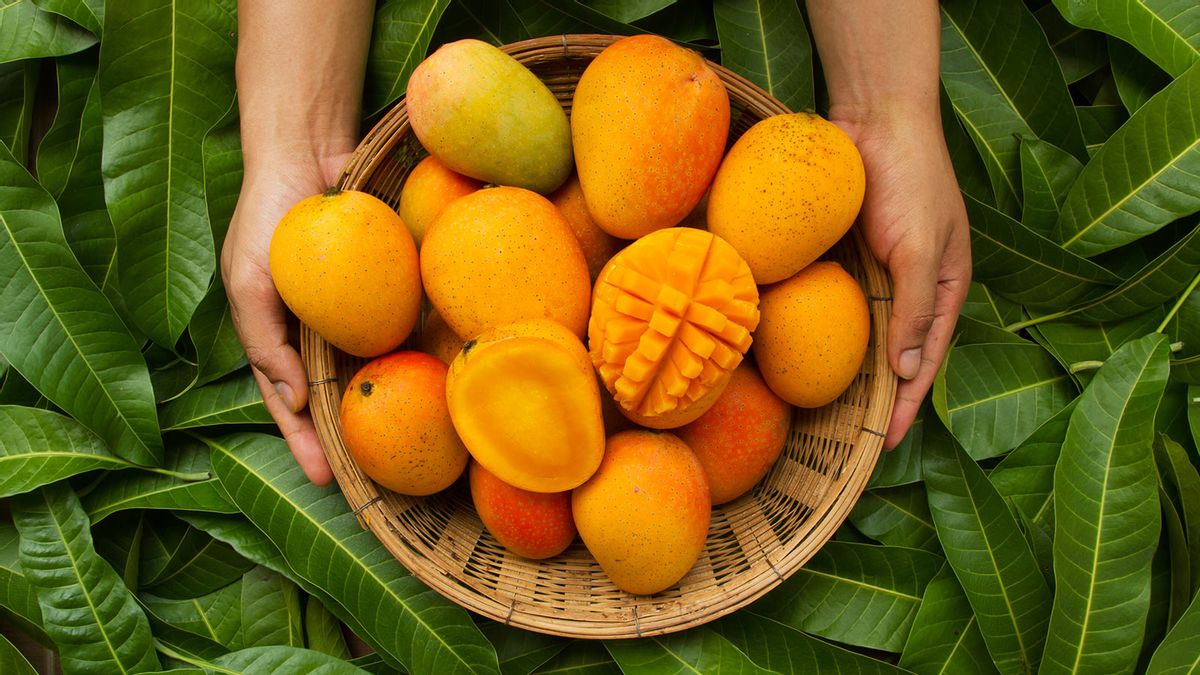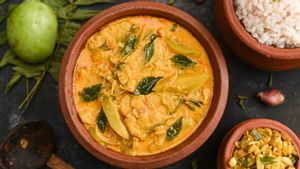A thick golden-hued liquid bubbled furiously in a large copper vessel while my husband’s granmai or granny watched it with a hawk’s eye, stirring it furiously with a wooden spoon, as the sweet aroma wafted in the air through my nostril—this is a scene from granmai’s kitchen in Goa, one hot May, many eons ago, that is vividly etched in my memory. The sweet aromatic liquid being reduced on flame was mangad or mango jam, I was told, made using the Mussarat or Monserrate variety of local mangoes.
Childhood memories for most Goans in summer include climbing trees to steal mangoes from the neighbour’s backyard, even though one has trees in one’s own garden. The heady smell of the Zhad pike ambe or mangoes ripening on trees, is enough to make anyone partake in this mindless mischief.
In Goa, mangoes are the topic of conversation in every home, even before the onset of the season. From fretting over unseasonal rains spoiling the harvest, to discussing the rate per tree and, of course, relishing the mango till the polished seed is shines, is part of the summer ethos in this state.
The undisputed king
“The real king is here (Goa), and the rest are just runners-up,” are the kind of reactions that the beloved Mancurad, a variety of mango sparks off. Mancurad is something Goans are emotional about and debates about its superiority over Alphonso rage galore. Chef Avinash Martins of Cavatina admits, “The distinctive aroma of the Malcurad is the most important characteristic. Our elders used to say that if a Malcurad was stored in the kitchen, the whole house, (and I mean, the huge Indo-Portuguese houses) would be filled with its aroma.”
The second reason for Mancurad’s popularity is its taste. Martins explains, “It has a sweet and sour flavour combination, which is unique.” He goes on to explain that Mancurad is pulpy and less fibrous, unlike most mangoes. It also has a reddish hue to its yellow. “Stories say that it was the Goddess’ kiss that denoted the red on the mango.”
Indeed, the Mancurad is inimitable. Dr. A. R. Desai, Agriculture Scientist from ICAR Goa, emphasises that it is the orange to deep-orange pulp with its distinct, well-balanced sugar-acid ratio in a desirable proportion, which makes Mancurad unique and sought-after. The season for Mancurad starts in March and continues till the second fortnight of April, when Hilario, the other commercial variety makes an entry.
Such is the passion for Mancurad among Goans that, on World Environment Day (June 5), 2019, Goa witnessed its first-ever ‘Malcorada plantation drive’ organised by a non-profit organisation, Transform Goa, which encourages every Goan to plant at least one Malcorada tree, so that by the year 2035, the state will have enough mangoes to export.
The first pre-season harvest of Mancurad mangoes, at times, commands a premium of Rs 5,000-Rs 6,000 a dozen, based on the size of the fruits. Perpetually in competition with Alphonso or Hapus, from Maharashtra, Goans swear by its superiority.
Other varieties
In his book, ‘As Mangas de Goa’ or ‘The Mangoes of Goa’, Fernando do Rego throws light on the other varieties of Goan mangoes. He also states, “All of us eat mangoes when the season (March to May) of this delicious fruit of Goa is here. But few of us, maybe with the exception of Malcorada and Monserrate and perhaps Malgesa to some extent, may recognise these varieties.” “Goa is home to 100 types of mangoes. 'Mankurad' is considered to be the king of mangoes in Goa. The other varieties are Afons, Malges, Culas, Fernadin, Gonta, Mussarat, Gadgo, Chipnechim toran, Koler,” explains Rita Shinde of Rita's Gourmet, Goa. She was fortunate to have most of these mangoes grow in her orchard in Goa Velha.
Hilario, originally from the Hilario’s, a heritage property in Siolim, is the red variety usually bigger than Mankurad and known for its deep yellow sweet pulp. The attractive appearance apart, according to Dr. Desai, the clean taste, devoid of fibre, enhances its appeal. Malgesh, a popular table fruit variety, has two variations - Akno Malgesh, the high-grade variant and Khand Malgesh –a lower-grade one that comes with a bit of thick skin. Mussarat, also known as Monserrate de Bardez, named after the taluka where it originated, is a sweet and pulpy variety. Fernandin, is another late variety that has attractive skin colour on shoulders,
Dr. A.R. Desai from ICAR Goa, substantiates, “These varieties are not comparable to Mankurad and Hilario. We, at ICAR, have come out with ‘Cardozo Mankurad’, which bears fruits every year, though less in number in very young trees. The fruit quality is par excellence and is medium-large (275 to 350gms ) with attractive skin colour, fibre-free melting pulp of yellowish-orange colour, having an agreeable sugar-acid blend. Its season starts from April.”
Mankurad, Afons, Mussarat, Fernadin, Culas, Malges, Gadgo, Gonta are best enjoyed ripe. Other varieties like Goa Apus, Colaco, Furtad, Toranja, Costa, Cota, Rebello, Renoldo, Papel, Bindao, Maxima, Culas, Kerel are used in making pickles.
History
Although around in India for nearly 4000 years, mangoes were not really a very popular fruit in Goa before the arrival of Portuguese. Renowned agricultural scientist Dr Y.L. Nene in the research paper ‘Mango through Millennia,’ published in The Journal of Asian Agri-History 2001 states that it was the Jesuit priests who first began experimenting and grafting on Mango plants in Goa between 1550 and 1575 CE.
Mangoes in daily diet
Mangoes are now an integral part of the local diet in Goa during summer. Shinde elaborates, “The mango variety 'Chepnechim toran' is used to make pickled green mangoes in brine along with green chillies, ginger, bibe or cashew. This is then pressed under a heavy stone for days and when ready, preserved for consumption. Chepnechim Toran can also be used to make 'bharleli toran' with masala. Both these are relished with pez (Rice kanji).'Mango solan', is made with green mangoes after peeling, slicing and drying with sea salt. 'Miskut' pickle, enjoyed in the rainy season with rice and dry prawn curry, is made with the well-seasoned ‘Koler’ mango plucked normally during the month of May.”
She further quips, “A dish which is invariably made on a Sunday during mango season is 'Arroz Coco'- rice cooked in coconut extract, saffron, whole spices such as cloves, cardamom, cinnamon and served with ripe, chewable 'Gota' variety of mango. 'Sansav', the sweet and sour curry, is also made with 'Gota' and enjoyed with steamed rice.”

Chefs in hotels tend to favour Mancurad and use it creatively. Chef Sandeep Sreedharan of Mahe Goa, serves these with katta kanji, a rice porridge reduced to a thick consistency with grated coconut, salted jaggery-coconut caramel and roasted moong.
Eating the drool-worthy mango, simply as a fruit, in the messiest way and relishing its smooth, sweet and velvety taste, is what summer in Goa ultimately stands for.
Banner image for representational purposes only.




